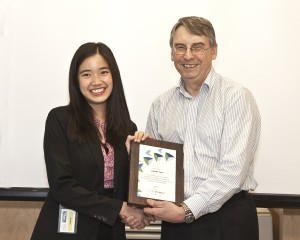Janelle Tam (high school student mentioned in my May 11, 2012 posting) was welcomed by CelluForce, the joint FPInnovation/Domtar company in Windsor, Québec, so she could demonstrate some of her nanocrystalline cellulose (NCC) research. Caroline Bouchard in a July 11, 2012 article for La Presse/La Tribune provides more information about the research and when any potential products might be created (Frrench language excerpt, I will attempt a translation),
Janelle Tam, une jeune Ontarienne de 17 ans, a découvert une substance bénéfique pour la santé à base de nanocellulose cristalline (NCC) telle que produite à l’usine Celluforce de Windsor.
Couplée chimiquement à des particules de carbone, la NCC, une substance extraite de la fibre du bois, serait un puissant agent antivieillissement et un antioxydant supérieur aux vitamines C et E.
Sans être considérée comme une véritable fontaine de jouvence, cette découverte s’avère prometteuse pour améliorer les produits de santé et anti-âge, des applications que Celluforce pourrait exploiter d’ici trois à cinq ans.
Translation here we go: Tam discovered a new substance, based on NCC, which is extracted from wood and produced by the CelluForce plant in Windsor, with anti-aging properties and superior anti-oxidant properties to vitamins C & E. The NCC is combined with carbon nanoparticles (specifically buckminster fullerenes). CelluForce may be able to exploit this health/beauty application in the next three to five years.
The CelluForce folks were so excited about Tam & her work they presented her with a plaque when she visited their plant on July 9, 2012,

Janelle Tam and Dr. Richard Berry, Vice President, Chief Technology Officer at CelluForce (courtesy: CelluForce)
Tam’s research opens a new opportunity for NCC research which, in Canada, has mainly focussed on textiles, composites, and coatings. Here’s Tam describing her work (from the Bouchard article),
«Les antioxydants préviennent et traitent des maladies. Ils peuvent aussi être utilisés dans la conservation des aliments et dans les produits anti-âge. Certains antioxydants sont toutefois toxiques, ou encore, ne sont pas solubles dans l’eau. Par exemple, les vitamines C et E se dégradent, alors quand elles sont présentes dans un produit cosmétique, leur effet diminue avec le temps. La NCC est naturelle, non toxique, soluble et stable. Elle peut aussi réagir à la température ou au pH», explique Janelle Tam, originaire de Singapour et étudiante de 12e année au Waterloo Collegiate Institute.
Rough (very) translation: Antioxidants can prevent and treat illness. They can also be used for food preservation and anti-aging. Some antioxidants are toxic and/or insoluble in water. For example, vitamins C & E degrade so when they’re present in a cosmetic the effect tapers off over time. NCC is natural, nontoxic, soluble, and stable. It also reacts to temperature or pH levels, explains Tam originally from Singapore and a student in grade 12 at Waterloo Collegiate Institute.
As the 2012 winner of the Sanofi BioGENEius Challenge Canada competition, Tam was invited to compete in this year’s international Sanofi BioGENEisu Challenge held in Boston, Massachusetts on June 19, 2012. Tam received an honourable mention for her work while Rui Song of Saskatoon placed third internationally. From the Sanofi BioGENEius Challenge Canada website,
A 16-year-old Saskatchewan girl with a goal of improving world health by engineering a more nutritious variety of lentil was among the top prize winners Tuesday June 19 at an international science competition for elite high school students.
Rui Song, a Grade 11 student at Saskatoon’s Walter Murray Collegiate, was awarded the $2,500 third place prize at this year’s International BioGENEius Challenge, conducted at the annual global BIO conference in Boston.
Janelle Tam, a Grade 12 student at Waterloo Collegiate Institute in Ontario, was awarded a $500 prize and honourable mention for her project — the invention of a disease-fighting, anti-aging compound using nano-particles from trees.
Both girls had earned berths in the international competition last month in the Sanofi BioGENEius Challenge Canada with first (Janelle) and second place (Rui) finishes.
Congratulations to both Rui Song and Janelle Tam.
I interviewed Dr. Richard Berry in my Aug. 27, 2010 posting where he very kindly answered my questions about cellulose, the nano kind and otherwise.
One final thought, why doesn’t CelluForce stimulate more innovative research on NCC by running a contest modeled on this Sanofi BioGENEius competition? They could call it something like the ‘CelluForce Creativity Crunch’.